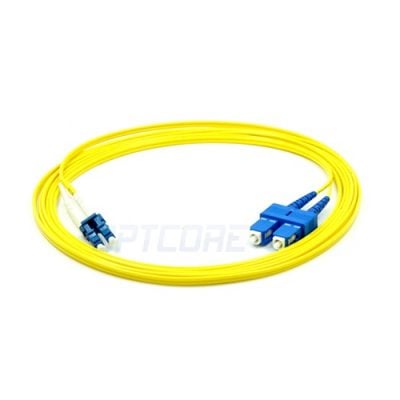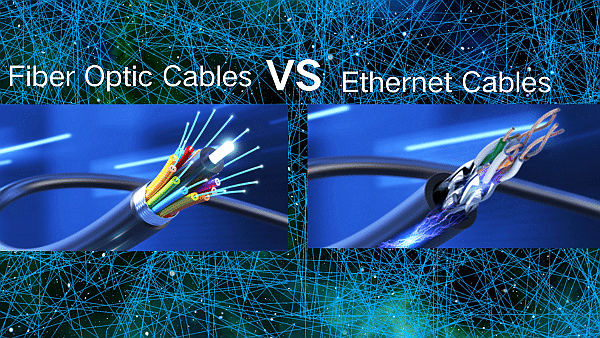Blog, Network Cabling
Fiber vs Ethernet Cable: Understanding the Key Differences
How is data exchanged across time and space? This process requires using two bridges: fiber optic cables and Ethernet cables. When considering fiber vs. Ethernet, what is the difference between Ethernet and fiber cable? Is fiber optic cable more advanced?
Let’s read this article with your questions, and you will get your answers.
Table of contents
Fiber Optic Cable
Fiber optic cables are made of glass fibers and transmit data using the principle of total light reflection.
Optical signals are generated by light-emitting diodes (LEDs) or semiconductor laser tubes. They are then transmitted through an optical fiber acting as a waveguide, carrying light from one cable end to another. The light signal is received by a photodetector, which converts it back into an electrical signal that the electronics can process.
Since light travels faster than electricity, fiber optic cables send signals faster. However, they have only become widely used in the last few years.

Fiber optic cables are divided into multimode and single-mode fiber optics. Multimode fiber uses wavelengths of 850 nm or 1310 nm for short-distance transmission, while single-mode fiber optics uses wavelengths of 1550 nm for long-distance transmission.
You can learn about the differences between Single-Mode and Multimode Fiber in our previous blog: Single Mode vs Multimode Fiber, What is The Difference?
Ethernet Cable
Ethernet or network cable is a widely used and proven cabling material. It typically consists of four pairs of copper twisted-pair wires with RJ45 connectors.
Ethernet cables are easy to install and maintain and compatible with various devices and operating systems. In addition, Ethernet networks can be easily expanded as the number of devices on the network increases and upgraded to faster speeds as technology advances.
Based on these advantages, Ethernet cables have become a widely used and proven form of cabling.

Currently, Ethernet cables are categorized into
- Cat5
- Cat5E (Super Category 5)
- Cat6 (Category 6)
- Cat6A (Super Category 6)
- Cat7 (Category 7)
- Cat7A (Super Category 7)
- Cat8 (Category 8)
You can learn about the differences between these cables in our previous blog: Cat5, Cat5e, Cat6, Cat6a, Cat7, Cat7a vs Cat8 Ethernet Cable, What is the difference?
Fiber vs. Ethernet Cable
| Fiber Optic Cable | Ethernet Cable | |
| Internal material | Fiberglass | Copper core |
| Transmission mode | Light pulses | Electrical impulses |
| Transmission rate | The transmission rate of optical fiber is much higher than that of network cables | Up to 40 Gbit/s |
| Transmission distance | The transmission distance of single-mode fiber can reach 10~20 kilometers. And multi-mode fiber can reach 2~3 kilometers. | The maximum theoretical transmission distance of an Ethernet cable is 100 m |
| Security | High, with good safety and anti-interference | It is low and susceptible to electromagnetic interference and hacker interception, posing a security and privacy risk. |
| Bandwidth | Wider bandwidth | Narrower bandwidth |
| Installation costs | The cost is higher | Lower cost |
| Weight | Lighter | Heavier |
| Damage | Fiber optic cables are fragile so that they can be easily damaged. | Ethernet cables are less fragile and, therefore, less prone to damage |
| Application scenarios | Higher | Lower |
| Application scenarios | Large enterprises, data centers, and application scenarios that require high speed and large capacity | Scenarios such as home, office, and small business |
| Power loss | Power loss is due to absorption, scattering dispersion, and bending. | Power loss due to conduction. |
Is Fiber Cable Better?
Fiber optics is undoubtedly better for performance, allowing fast data transfer. However, we must consider the existing infrastructure construction process, installation costs, maintenance costs, application scenarios, etc.
Ethernet cables are still widely used, but there is a clear trend towards phasing out Ethernet. It will take a long time, but as science and technology develop, the process may be accelerated.
Conclusion
Ethernet and fiber optic cables are indispensable materials for network cabling, and it is wise to choose the cable that is suitable for your needs.
Today, whether you choose Ethernet or fiber optic, we have the cables you need to complete your network cabling. Our website is well-stocked with products, including fiber patch cables, network cables, and the necessary connectors and tools. You can also customize the length of cable you need.
FAQ
Q: Is fiber optic cable better than Ethernet cable?
A: Regarding speed, fiber optic cable is faster than Ethernet (twisted pair) cable. However, in terms of installation cost, fiber optic cable costs more. Read the comparison section above for more information.
Q: Is Cat7 fiber cable?
A: Cat7 stands for Category 7 twisted pair copper cable. It is not a fiber optic cable.
Q: What materials are used in fiber optic cables?
A: The typical structure of an optical fiber is an elongated multilayer coaxial cylindrical solid composite fiber. From the inside out, the core, the cladding, the coating, and the outermost layer are the sheath. The core fiber is usually made of glass (silica) or plastic.
Currently, the most dominant communication fiber material is high-purity quartz glass-based. Generally, the core is made of quartz fiber, the cladding is made of glass, the coating is made of polyurethane or silicone resin, and the sheath is made of plastic, such as nylon or polyethylene.
Plastic fibers tend to be more economical and easier to use due to their increased flexibility, lighter weight, and resistance to bending and vibration. They are typically used in applications where transmission rates and speeds are less demanding, and the risk of mechanical stress is lower.
Q: Should I choose Ethernet or fiber optic cable to set up my home or small office network?
A: Ethernet cable is the most accessible, affordable, and straightforward solution. Determine how much shielding you need and at what data rate, and buy the appropriate cable category. The RJ45 connector is standard, so it’ll be easier to set up, run, and access than the powerful fiber optic alternatives.
Reference







